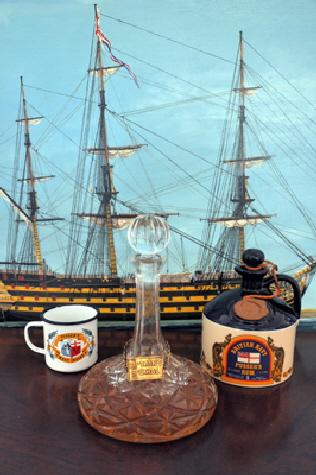During the great age of discovery, ships were at sea for long periods and with large crews that presented provisioning problems, particularly water. Stored in wooden barrels and unrefrigerated, the water did not keep well and algae and surface scum soon formed. Beer was also carried but quickly went bad in the humid tropical climates that the ships now visited. Hard liquor took up less room than water and was sweeter, and after the capture of Jamaica by the British from the Spanish, native sugar-cane rum became plentiful, and soon found its way smuggled aboard the ships, accompanied with inevitable drunkenness and lack of discipline.
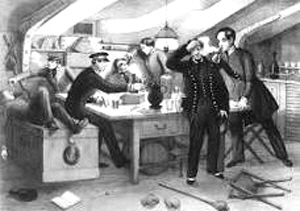
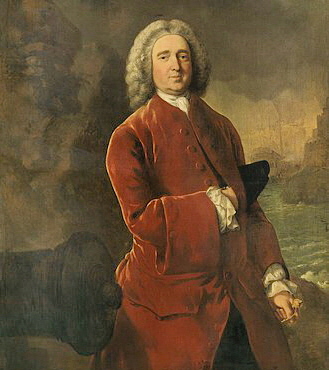 Admiral Edward Vernon was commander of the British Navy's West Indies squadron in 1740 and took it upon himself to "legalize" the illicit smuggling of the spirit. He authorized the issue of a pint of rum each day to ratings in his squadron and also ingratiated himself with all the men, by giving each a share of a great hoard of Spanish treasure they had captured in Jamaica. One pint of neat rum each day, in the humid tropical climate. did not eliminate drunkenness, so on 21 August that year, (a day that would live in infamy), Vernon ordered that the rum for ratings should be diluted with water, two parts water to one part rum, supposedly to increase the health and moral wellbeing of the men - which it didn't. Before it was mixed the water was aired out in open buckets or tubs called "scuttle butts," which allowed it to lose the slimy flavor of the cask. Later sugar and lime juice were added to make the rum mixture less bitter. Even before this, Admiral Vernon's nickname was "old grog" because he wore a coat of grogram cloth, which is a loosely woven fabric made of silk blended with mohair or wool, with the feel of velvet. His diluting order was not popular with the men who called the weaker drink "grog" in a derisory reference to their commander. From this came the term "groggy" meaning someone who has had too much to drink and unstable on their feet. Adding lime juice to their tot also gave rise to the nickname "Limey' for British sailors, and even to describe the British people as a whole.
Admiral Edward Vernon was commander of the British Navy's West Indies squadron in 1740 and took it upon himself to "legalize" the illicit smuggling of the spirit. He authorized the issue of a pint of rum each day to ratings in his squadron and also ingratiated himself with all the men, by giving each a share of a great hoard of Spanish treasure they had captured in Jamaica. One pint of neat rum each day, in the humid tropical climate. did not eliminate drunkenness, so on 21 August that year, (a day that would live in infamy), Vernon ordered that the rum for ratings should be diluted with water, two parts water to one part rum, supposedly to increase the health and moral wellbeing of the men - which it didn't. Before it was mixed the water was aired out in open buckets or tubs called "scuttle butts," which allowed it to lose the slimy flavor of the cask. Later sugar and lime juice were added to make the rum mixture less bitter. Even before this, Admiral Vernon's nickname was "old grog" because he wore a coat of grogram cloth, which is a loosely woven fabric made of silk blended with mohair or wool, with the feel of velvet. His diluting order was not popular with the men who called the weaker drink "grog" in a derisory reference to their commander. From this came the term "groggy" meaning someone who has had too much to drink and unstable on their feet. Adding lime juice to their tot also gave rise to the nickname "Limey' for British sailors, and even to describe the British people as a whole.
Rum lasted longer, took up less room on board, and was sweeter than water or beer, and even grog soon became the stalwart of the British Fleets. This rum was 95.5 % proof or 54.6% alcohol by volume. The term "proof" has gone through many alcohol strength changes since 1655 when it was an extremely strong liqueur, reputed to be the equivalent of four double scotches. By contrast, Pussers Rum, made by the Pussers company in the British Virgin Islands, is called 95.5% proof, but is not the same specification as the original. An early method of testing was the gunpowder test, where gunpowder was soaked in the rum, and if it still burned the spirit was called "over proof." Over proof is the equivalent of 150% proof nowadays.
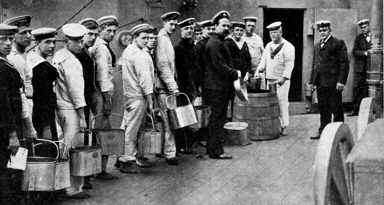 The daily grog issue was one pint per day for men over age 20, and half a pint for boys as young as 14. Half a pint was issued around noon, and the other half about 5 pm. It was called the "Pusser's rum" since the ship's purser was in charge of the issue. Petty Officers were served at 11 am to the piping of "up spirits" on the quarterdeck. They had their jugs filled according to how many men were in their mess. At noon "muster for rum" was piped for the ratings and the cook from each mess presented their tin buckets. There then followed the time of great barter in the messes, even though it was forbidden to even share your grog with a fellow shipmate. Some would sell their ration to messmates, others offered "sippers," a small sip – for a price, "gulpers" was a large swig, and "sandy bottoms" was the remainder of the cup after the owner had had his fill. Those who did not take their rum had three pennies per day added to their pay.
The daily grog issue was one pint per day for men over age 20, and half a pint for boys as young as 14. Half a pint was issued around noon, and the other half about 5 pm. It was called the "Pusser's rum" since the ship's purser was in charge of the issue. Petty Officers were served at 11 am to the piping of "up spirits" on the quarterdeck. They had their jugs filled according to how many men were in their mess. At noon "muster for rum" was piped for the ratings and the cook from each mess presented their tin buckets. There then followed the time of great barter in the messes, even though it was forbidden to even share your grog with a fellow shipmate. Some would sell their ration to messmates, others offered "sippers," a small sip – for a price, "gulpers" was a large swig, and "sandy bottoms" was the remainder of the cup after the owner had had his fill. Those who did not take their rum had three pennies per day added to their pay.
Just as Vernon's nickname slipped into British history, it also passed into American history. In the campaign against Cartagena in 1741, Vernon's ships carried some 3,000 American Colonial volunteers, one of whom was Lawrence Washington, a captain of marines, and the older brother of George Washington. When he returned to his plantation in Virginia he renamed it Mount Vernon, after his beloved admiral.
The rum ration was not limited only to the British navy. In 1794 the United States Navy followed suit by issuing “half a pint of distilled spirits a day.” This was half the ration of British sailors, and those who did not wish to imbibe or were under age, were paid an extra three to six cents a day. In 1806 the US Navy tried to encourage Bourbon as a substitute for the more expensive rum, but it was not popular. The rum ration was temporarily stopped during the American Civil war, and finally, on July 1st 1914, an order was signed by Josephus Daniels, the Secretary of the Navy, prohibiting all alcoholic drink on US Navy ships. As with Admiral Vernon's order this was not well received and Daniels was accused of caving in to the temperance movement. The Royal Australian Navy and the Royal New Zealand Navy maintained the tradition even after the British ended it in 1970, and the RNZN only stopped the daily tot in February 1990, 20 years after the British.
Many legends are associated with the daily tipple. One grew after Lord Nelson was shot and killed during the battle of Trafalgar on 21st October 1805. After HMS Victory had been towed into Gibraltar, his body was placed in a barrel of brandy for the four-week journey back to England in a hastily repaired Victory. However, after removal of the corpse from the barrel in Portsmouth, it was discovered that most of the spirit was gone, because holes had been drilled in the sides of the barrel and sailors had been siphoning the liquid out and drinking it. A much more colorful legend then prevailed that Nelson had been pickled in rum, and where the term "Nelson's blood" comes from when drinking any rum. Whatever it was they were drinking, it was quite likely diluted by Nelson's putrefying body.
What is known is that Nelson, (who was actually teetotal himself), ordered a double-tot throughout his fleet of thirty-three ships as they slowly bore down on the combined French and Spanish fleet, off Cape Trafalgar, near Cadiz. The combined fleet were then totally decimated in five hours of intense battle, mainly due to the speed and accuracy of the British gunners. This victory effectively saved England from invasion by Napoleon's army, who were amassing on the French side of the 22-mile wide English Channel, but dared not attempt to cross because the British navy patrolled the channel. It is therefore said that neat rum, and definitely not grog, saved Old England from certain invasion.
Complaints continually came to The Admiralty in London from officers about the unruliness of men who were continually drunk, and they urged the reduction of the daily rum allotment. But the war with Napoleon was, in the words of Wellington, "A close run thing," and Grog advocates believed that the drink was one of the few comforts the common sailor had, and should not be reduced without increased pay. British ships spent dreary months in fair and foul weather blockading French ports, sometimes in near mutinous conditions, and the Admiralty was unwilling at the time to do anything that would upset the crews.
In 1850 the rum ration was reduced to one-eighth pint per day, and to make the reduction easier to take the Admiralty raised pay and meat and sugar allowance for each man. They were also given a choice of a further rise in pay if they did not take the daily tot. The afternoon issue was also changed to be served with the evening meal, which meant that men were not drinking on an empty stomach.
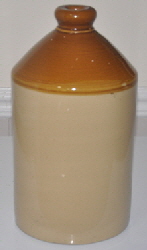 On 28th January 1970, there was a contentious debate in the British House of Commons, whether to keep the daily tot. This was causing concern, due to the increased complexity of working machinery on Navy ships. Finally. on the 31st of July that year, called "Black Tar Day", was the last day of the issue of rum in the Royal Navy, and a tradition for over 200 years came to an end. Ratings were given an extra can of beer as compensation.
On 28th January 1970, there was a contentious debate in the British House of Commons, whether to keep the daily tot. This was causing concern, due to the increased complexity of working machinery on Navy ships. Finally. on the 31st of July that year, called "Black Tar Day", was the last day of the issue of rum in the Royal Navy, and a tradition for over 200 years came to an end. Ratings were given an extra can of beer as compensation.
The remaining rum stocks were auctioned, and bought by a merchant called Brian Cornford, and shipped to Gibraltar, where it was sold in wicker-covered pot demijohns for approximately $6.00 a gallon.
When my wife and I, with our two small children, lived on our 40’ foot ketch “Tranquility Base,” from 1977 to 1982 we always wintered in Gibraltar. I would always buy a couple of gallons of rum, before sailing further into the Mediterranean to charter our boat for the summer. Both grog or "neaters" was offered to guests at dinner, thereby maintaining a true British Naval tradition on a British yacht. This was genuine navy rum and at two parts water to one part rum the drink had a bitter taste, but at the price we paid, there was little incentive to dilute it into grog. I found that using distilled water improved the taste somewhat, and adding sugar sweetened it. In its raw form it is a very powerful drink, that leaves a strong aftertaste on the palette and a very warm feeling in the stomach. There were few of our guests who could handle more than a few “neaters”, and none who ever managed half a pint twice a day, without becoming completely inebriated.
The Gibraltar stock is now long gone, but the Pusser's Rum company in The British Virgin Islands still makes their rum under the brand name, "Pusser's", but they use a mixture of five West Indian rums. There are now many different recipes for “grog” and many drinks called grog, but there is little to compare with a tot of the real thing.
Wherever they be in the world, all British yachtsmen worth their salt will offer a toast with a shot of rum to “The immortal memory” on 21st October at 4.30 pm, Greenwich Mean Time (GMT), the exact time of Admiral Horatio Nelson’s death.
